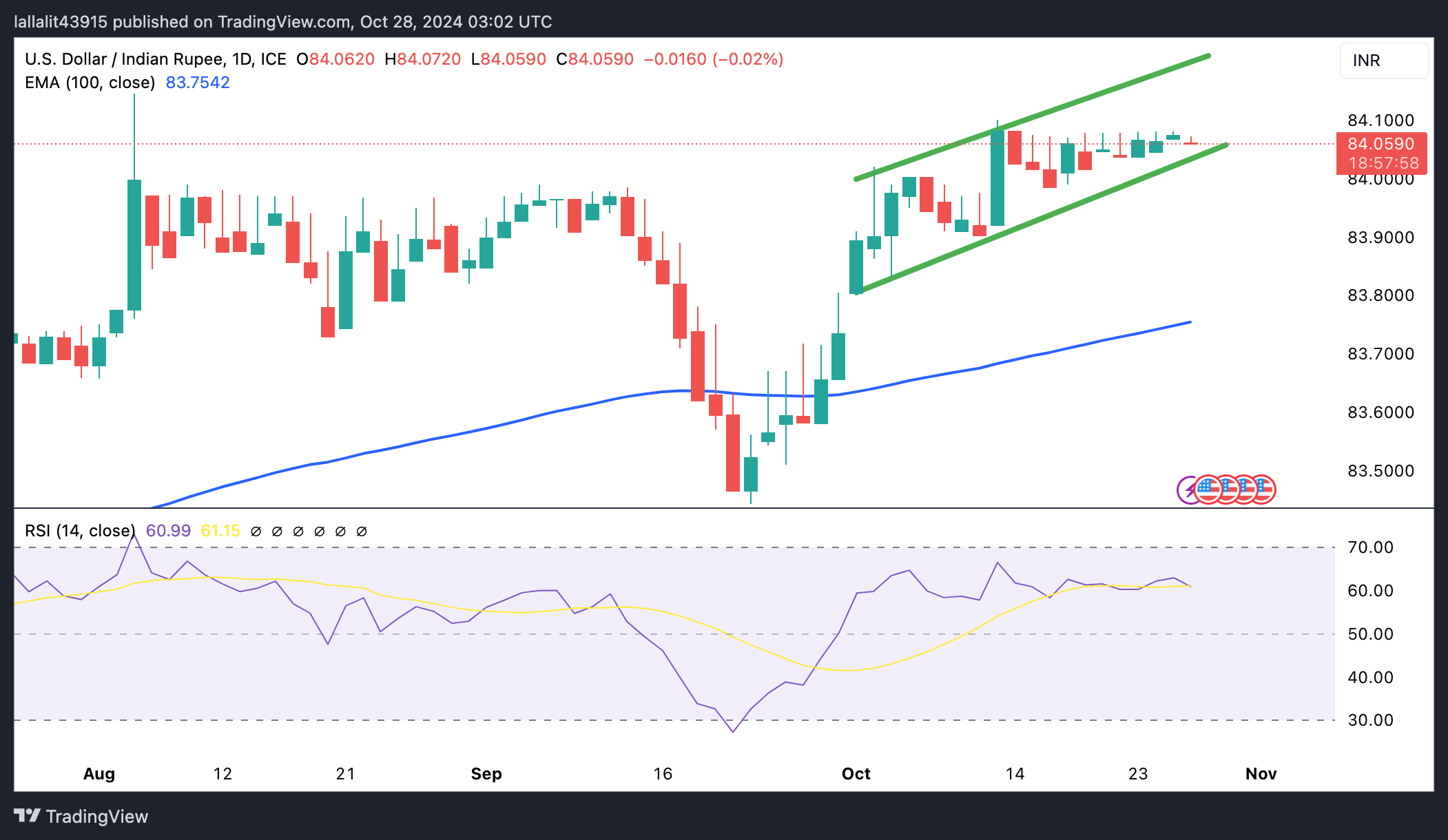- The Indian Rupee trades flat in Monday’s early European session.
- Lower crude oil prices underpin the INR, but persistent Indian foreign outflows could cap its upside.
- Investors await the advanced US GDP growth numbers for Q3 on Wednesday ahead of NFP data.
The Indian Rupee (INR) trades on a flat note on Monday despite the stronger US Dollar (USD). The fall in crude oil prices could provide some support to the local currency as India is the world's third-largest oil consumer. However, the upside of the INR might be limited amid sustained foreign outflows from domestic stocks and the expectation of a slower pace of the US Federal Reserve (Fed) rate cuts.
Investors will keep an eye on the advanced US Gross Domestic Product (GDP) Annualized for the third quarter (Q3), which is due on Wednesday. The Core Personal Consumption Expenditures (PCE) Price Index for September will be released on Thursday. On Friday, the highly anticipated US Nonfarm Payrolls (NFP) will be in the spotlight.
Daily Digest Market Movers: Indian Rupee flat lines, the potential upside seems limited
- India’s economic growth is estimated to reach between 7.0% and 7.2% in the fiscal year 2024-25, according to Deloitte India’s latest Economic Outlook.
- The preliminary estimates showed that India’s HSBC Manufacturing Purchasing Managers Index (PMI) rose to 57.4 in October versus 56.5 prior. The Services PMI increased to 57.9 in October from a one-year low of 57.7 in September.
- The US Michigan Consumer Sentiment Index rose to 70.5 in October from 68.9 in the previous reading, beating expectations.
- The Durable Goods Orders declined by 0.8% MoM in September, above the market consensus of a 1% decline. Durable Goods Orders excluding transportation increased 0.4% in September.
- US rate futures have priced in a 97.7% possibility that the Fed will cut rates by 25 basis points (bps) in November, according to the CME FedWatch tool.
Technical Analysis: USD/INR’s constructive outlook remains in play
The Indian Rupee trades sideways on the day. According to the daily chart, the bullish outlook of the USD/INR pair remains intact, with the price holding above the key 100-day Exponential Moving Average (EMA). The 14-day Relative Strength Index (RSI) stands above the midline near 60.00, suggesting that further upside looks favorable.
Sustained trading above the upper boundary of the ascending trend channel of 84.20 could pave the way to 84.50, en route to the 85.00 psychological level.
On the flip side, the initial support level emerges at the lower limit of the trend channel near 84.05. The next contention level is seen at 83.75, the 100-day EMA.

Indian Rupee FAQs
The Indian Rupee (INR) is one of the most sensitive currencies to external factors. The price of Crude Oil (the country is highly dependent on imported Oil), the value of the US Dollar – most trade is conducted in USD – and the level of foreign investment, are all influential. Direct intervention by the Reserve Bank of India (RBI) in FX markets to keep the exchange rate stable, as well as the level of interest rates set by the RBI, are further major influencing factors on the Rupee.
The Reserve Bank of India (RBI) actively intervenes in forex markets to maintain a stable exchange rate, to help facilitate trade. In addition, the RBI tries to maintain the inflation rate at its 4% target by adjusting interest rates. Higher interest rates usually strengthen the Rupee. This is due to the role of the ‘carry trade’ in which investors borrow in countries with lower interest rates so as to place their money in countries’ offering relatively higher interest rates and profit from the difference.
Macroeconomic factors that influence the value of the Rupee include inflation, interest rates, the economic growth rate (GDP), the balance of trade, and inflows from foreign investment. A higher growth rate can lead to more overseas investment, pushing up demand for the Rupee. A less negative balance of trade will eventually lead to a stronger Rupee. Higher interest rates, especially real rates (interest rates less inflation) are also positive for the Rupee. A risk-on environment can lead to greater inflows of Foreign Direct and Indirect Investment (FDI and FII), which also benefit the Rupee.
Higher inflation, particularly, if it is comparatively higher than India’s peers, is generally negative for the currency as it reflects devaluation through oversupply. Inflation also increases the cost of exports, leading to more Rupees being sold to purchase foreign imports, which is Rupee-negative. At the same time, higher inflation usually leads to the Reserve Bank of India (RBI) raising interest rates and this can be positive for the Rupee, due to increased demand from international investors. The opposite effect is true of lower inflation.
Information on these pages contains forward-looking statements that involve risks and uncertainties. Markets and instruments profiled on this page are for informational purposes only and should not in any way come across as a recommendation to buy or sell in these assets. You should do your own thorough research before making any investment decisions. FXStreet does not in any way guarantee that this information is free from mistakes, errors, or material misstatements. It also does not guarantee that this information is of a timely nature. Investing in Open Markets involves a great deal of risk, including the loss of all or a portion of your investment, as well as emotional distress. All risks, losses and costs associated with investing, including total loss of principal, are your responsibility. The views and opinions expressed in this article are those of the authors and do not necessarily reflect the official policy or position of FXStreet nor its advertisers. The author will not be held responsible for information that is found at the end of links posted on this page.
If not otherwise explicitly mentioned in the body of the article, at the time of writing, the author has no position in any stock mentioned in this article and no business relationship with any company mentioned. The author has not received compensation for writing this article, other than from FXStreet.
FXStreet and the author do not provide personalized recommendations. The author makes no representations as to the accuracy, completeness, or suitability of this information. FXStreet and the author will not be liable for any errors, omissions or any losses, injuries or damages arising from this information and its display or use. Errors and omissions excepted.
The author and FXStreet are not registered investment advisors and nothing in this article is intended to be investment advice.
Recommended content
Editors’ Picks

AUD/USD: Further gains need more conviction
AUD/USD reversed two-daily pullbacks in a row on Tuesday, staging a decent comeback from Monday’s troughs near 0.6220 to the boundaries of the 0.6300 hurdle propped up by the RBA hawkish hold and firm data from Chinese business activity.

EUR/USD remains offered below 1.0800 ahead of “Liberation Day”
EUR/USD came under extra downside pressure on Tuesday, returning to the sub-1.0800 region on the back of tepid gains in the US Dollar and rising caution prior to Trump’s announcements on Wednesday.

Gold nears $3,100 as fears receded
Gold is easing from its fresh record high near $3,150 but remains well supported above the $3,100 mark. A generalised pullback in US yields is underpinning the yellow metal, as traders stay on the sidelines awaiting clarity on upcoming US tariff announcements.

Bitcoin just as vulnerable as major assets – Anthony Yeung, Global Head of Strategic Development at CoinCover
Bitcoin trades under the $85,000 mark, holding on to nearly 3% gains on Tuesday ahead of Donald Trump’s Liberation Day. Crypto traders remain fearful, the sentiment reads 34 on a scale of 0 to 100 on the Fear & Greed Index.

Is the US economy headed for a recession?
Leading economists say a recession is more likely than originally expected. With new tariffs set to be launched on April 2, investors and economists are growing more concerned about an economic slowdown or recession.

The Best brokers to trade EUR/USD
SPONSORED Discover the top brokers for trading EUR/USD in 2025. Our list features brokers with competitive spreads, fast execution, and powerful platforms. Whether you're a beginner or an expert, find the right partner to navigate the dynamic Forex market.

